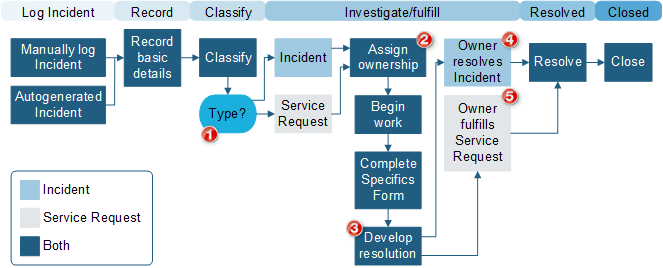Incident and Service Request Workflow
Incidents and Service Requests have similar (but slightly different) workflows.
The following figure describes the high-level Incident/Request workflow.

| 1 |
The choice between Incident and Service Request is automatically determined by CSM:
Incidents are investigated and resolved, Service Requests are fulfilled. |
| 2 |
|
| 3 |
Owner:
|
| 4 |
Owner resolves the Incident by:
|
| 5 |
Owner fulfills the Service Request by:
|
Contributors
An Incident or a Request typically involves the following contributors. Depending on your workflow and the size of your company, some of these contributors might be combined into one person:
- Requester: Person who initiates the Incident/Request. This is typically a customer.
- Creator: User who first logs the Incident/Request. This is a user; the level varies depending on tiered support.
- Owner: User who manages (investigates/resolves/fulfills) the Incident/Request. This is typically a technician; the level varies depending on tiered support.
- Task owner: User to whom Tasks are assigned in order to help resolve/fulfill an Incident/Request (example: Work Unit owner, Approval owner).
Statuses
An Incident or a Request progressing through the workflow encounters the following statuses:
- New: Incident/Request is being created, recorded (initial details), classified, and assigned to an owner.
- Assigned: Incident/Request has been assigned to an owner.
- In Progress: Incident/Request is being investigated/fulfilled and resolved by an owner.
- Pending: Incident/Request is temporarily paused (Stop The Clock).
- Resolved: Incident/Request has been resolved and is waiting to be closed.
- Closed: Incident/Request is closed.
- Reopened: Incident/Request is reopened because the issue was not fixed or reoccurred.